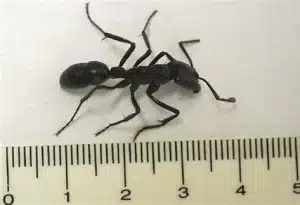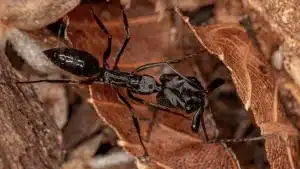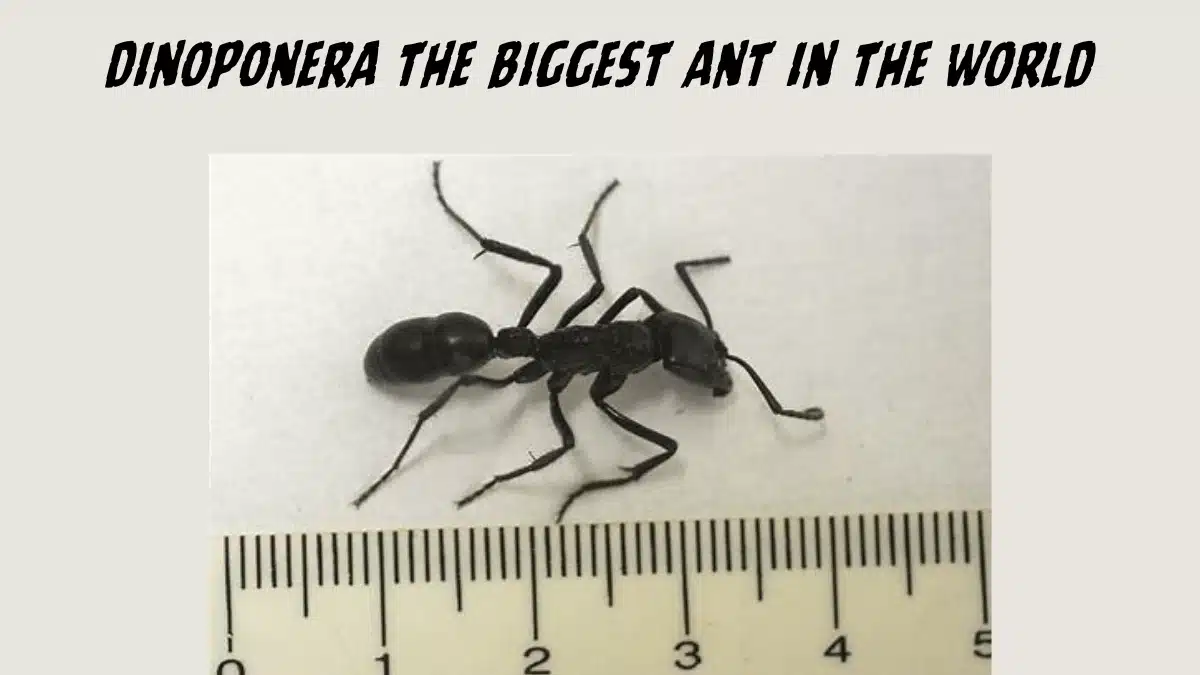Did you know? “Genus dinoponera” of South America is the biggest ant in the world!
I have been stung often from dinoponera, so I know that getting stung again will hurt a lot.
However, it is quite dangerous. If you ever encounter big ants, please don’t attempt this.
Looking closely at it, you will see it is an amazing creature.
Table of Contents
So, let’s get started!
Facts Of Genus Dinoppnera
| FACT | INFORMATION |
| SCIENTIFIC NAME | Dinoponera |
| LIFESPAN | Unknown, likely several years |
| TOP SPEED | Unknown, but can move quickly |
| WEIGHT | Up to 3.5 grams |
| LENGTH | Up to 5 centimeters |
| KINGDOM | Animalia |
| PHYLUM | Arthropoda |
| CLASS | Insecta |
| ORDER | Hymenoptera |
| FAMILY | Formicidae |
| GENUS | Dinoponera |
| SPECIES | Multiple, including Dinoponera gigantea and Dinoponera quadriceps |
Which Is The Biggest Ant In The World

Genus Dinoponera is one of the most awesome creatures. It looks beautiful while cleaning its antennae.
It uses its mandibles to keep them clean, which are its primary sensory mechanisms.
It is extraordinary to see an animal this size with such a powerful sting that can hinder an animal as big as me.
However, even though I am much larger, I would cry on the floor if this ant were to sting me.
This is truly amazing and shows how incredible Mother Nature is.
Astonishingly, an animal this size can make a big animal like me cry.
What Does Genus Dinoponera Eat

Dinoponera ants are predatory insects. They have a primarily carnivorous diet. Some of the available foods of Dinoponera ants include:
Dinoponera ants are active hunters. They search for and capture different types of arthropods, such as insects, spiders, millipedes, and centipedes.
These animals catch and control their prey by using their strong jaws.
Cockroaches, katydids, beetle larvae, caterpillars, and other small creatures are often hunted by predators.
Sometimes, Dinoponera ants hunt and eat small vertebrates such as frogs, lizards, mice, and other animals.
According to reports, Dinoponera ants are known to eat dead or trapped vertebrates in the wild. But they don’t eat a lot of vertebrates.
- Wounded or dead animals: Dinoponera ants are opportunistic foragers and scavengers. They readily feed on wounded, dying, or dead arthropods and vertebrates that they come across. Carrion is an important nutrient source for Dinoponera ants, especially for colony growth.
- Nectar and honeydew: Though principally carnivorous, Dinoponera ants also collect nectar, fruit pulp, and honeydew as food. Nectar and honeydew provide an important source of carbohydrates and sugars in their diet.
- Eggs of other arthropods: Where possible, Dinoponera ants prey on the eggs of other insects and arthropods. Eggs provide a rich source of proteins, fats, and nutrients for developing larvae in the nest.
Is There A King Of Ants
No, ants in a colony do not have a king or anything similar. Ant colonies are fascinating because they live in big groups, and their generations overlap.
Did you know that ants also have a division of labor? Each ant has its specific job.
Did you know that ant colonies have a fascinating social structure? Three types of ants play different roles and work together.
Workers resemble ants because they are unable to have babies. Every day, the colony members are busy completing important tasks.
They have to do a few tasks. They must find food, build and care for the nest, and look after the larvae.
Do you know that workers make up the majority of ants in a colony?
The queen ant holds the title of queen in a colony. She has one important job: to mate and lay eggs.
The queen ant remains inside the nest while the worker ants take care of all the tasks for the colony.
Male ants can reproduce. Ants have a very important job. Their job is to mate with a queen ant.
In the colony, male ants die shortly after they mate.
How Strong Are Ants

Ants are very strong relative to their body size.
An average worker ant can carry 10 to 50 times its own body weights, equivalent to a human lifting over 6 tons!
Some specific examples of ant strength:
- Leafcutter ants can carry segments of leaves that weigh up to 50 times their body weight.
- Weaver ants can bind leaves together with silk and lift them off the ground. A group of 20 ants can lift a mass of 5000 times their body weight.
- Fire ants can work together in large numbers to move very heavy objects. They use their jaws to grip the object and their legs to push in a coordinated fashion.
Video of Biggest Ant!!!
Conclusion
In conclusion, the genus Dinoponera of South America is the biggest ant in the world, with a powerful sting that can incapacitate animals much larger than itself.
These predatory insects have a primarily carnivorous diet and are active hunters, capturing various arthropods and small vertebrates and scavenging on carrion.
Ants are fascinating creatures with a unique social structure; each ant has a specific job within the colony.
Ants are also incredibly strong relative to their body size, with some species able to carry objects many times their body weight.
While some ants can fly, most do not have this ability.
I hope you enjoy reading this; tell us what you like the most about the genus dinoponera!
FAQ.s
Can ants fly?
Ants, for the most part, cannot fly.
Some ants can fly, but not all ants. Carpenter ants, red ants, and fire ants are the types of ants that have wings and can fly.
They fly when they want to mate or start a new colony.
The queen ant takes flight just once in her entire life. This special flight happens when she is ready to find a mate.
Once she finishes her flight, her wings come off. The ants that work do not have wings.
What is the smallest Ant?
The smallest known ant is the Pharaoh ant (Monomorium pharaonis), which is only about 1.5 mm long. Some other very small ants include:
– Crematogaster pygmaea: About 1.5 mm long, found in Australia
– Monomorium minimum: 1.2 mm, found in Sri Lanka
– Mycocepurus goeldii: 1.2 mm, found in Central and South America
Related Articles
Do Ants Poop Or Frass | Top Facts And Science Behind It!
Sugar Ant Bites | Tips N Tricks To Treat Them (Proper Guide)
Ant Eggs | How Do I Get Rid Of Ant Eggs? Top Surprising Facts!
